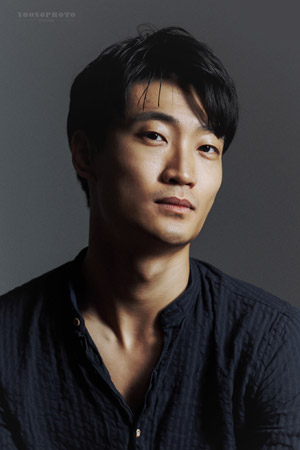
... Kimin Kim is a dancer it is hard to describe without drowning in superlative adjectives. But it could be no other way, as he is one of those selected few who are born to live and breathe through dance. “He is ready for some feat, executed with zeal, with a gaze in which there lies the fire of discovery”; these lines from Mahabarata are said as if about Kimin Kim performing kshatriya. His Solor is inexpressibly poetic, refined in its flight, like some arrow released from a bow. His appearance in the Kingdom of Shades (or rather it would be better to say his soaring in four impetuous leaps into the Kingdom), just a few moments before Nikia’s shade descends from the Himalayas, is anticipated each and every time as a miracle, as a mystery that one can touch for just a few seconds before it dissipates in the gloom.
BEATRICE MAGAZINE
Kimin Kim is certainly one of the great dancers of today. Technically he is superb, with a spectacularly high jump, smooth, musical turns that go purring round like a Rolls-Royce engine, and a steely core that enables him to be in complete control over the most demanding of adagio movements. His elegant physique adds to the sense of nobility his bearing and head carriage convey and enhances his lovely arabesque line. What lifts him onto an even higher plane is his musicality; he melds the movement with the dynamics of the music so that they become one, as Petipa and Ivanov intended, and it is a pleasure to watch.
Amanda Jennings. St Petersburg Ballet Theatre Swan Lake. Dance Europe. 2018, October.
Mariinsky Theatre Principal Dancer Kimin Kim did not perform the role of the God of the Wind, though, it seemed, it really was he – he flew over the huge stage of the Bolshoi Theatre, as though absolutely defying the laws of gravity, and produced inspired whirls of pirouettes.
Kommersant
Repertoire includes:
Giselle (Count Albrecht, Classical Duet); choreography by Jean Coralli, Jules Perrot and Marius Petipa,
La Fille du Pharaon (Ta-Hor); choreography by Marius Petipa reconstructed by Toni Candeloro,
La Bayadère (Solor, Golden Idol); choreography by Marius Petipa, revised version by Vladimir Ponomarev and Vakhtang Chabukiani (Dance of the Golden Idol choreographed by Nikolai Zubkovsky),
The Sleeping Beauty (Prince Désiré); choreography by Marius Petipa, revised version by Konstantin Sergeyev,
Swan Lake (Prince Siegfried, the Prince’s Friends); choreography by Marius Petipa and Lev Ivanov, revised version by Konstantin Sergeyev,
Don Quixote (Basilio); choreography by Alexander Gorsky,
the Diane and Actéon Pas de Deux from the ballet La Esmeralda (Actéon); choreography by Agrippina Vaganova,
Romeo and Juliet (Romeo, Mercutio); choreography by Leonid Lavrovsky,
Shurale (Ali-Batyr); choreography by Leonid Yakobson,
George Balanchine's ballets Jewels (Rubies, Diamonds), Symphony in C (III. Allegro vivace), A Midsummer Night’s Dream (Pas de deux from Act II) and Tchaikovsky Pas de Deux,
The Nutcracker (Nutcracker Prince); choreography by Vasily Vainonen,
Le Corsaire (Ali); production by Pyotr Gusev after the composition and choreography of Marius Petipa,
Michel Fokine’s ballets Le Spectre de la rose (Ghost of the Rose) and Schéhérazade (the Slave),
Études; choreography by Harald Lander,
Le Jeune homme et la mort; choreography by Roland Petit,
Sylvia (Aminta), Marguerite and Armand (Armand); choreography by Frederick Ashton,
The Legend of Love (Ferkhad); choreography by Yuri Grigorovich,
Leningrad Symphony (Youth); choreography by Igor Belsky,
Push Comes to Shove; choreography by Twyla Tharp,
The Vertiginous Thrill of Exactitude; choreography by William Forsythe,
Le Parc (Soloist); choreography by Angelin Preljocaj,
Concerto DSCH, Cinderella (Prince), Pierrot Lunaire,
Infra; choreography by Wayne McGregor
and Paquita (Andrés); choreography by Yuri Smekalov, reconstruction and staging of Marius Petipa's choreography (Act III Grand Pas) by Yuri Burlaka,
A csodálatos mandarin (Mandarin); choreography by Yuri Possokhov,
Coppélia (Frantz); choreography by Alexander Sergeev.
Repertoire also includes:
Pas de deux from the ballet The Talisman; choreography by Marius Petipa,
Sadness; choreography by Youngjun Shin.
In 2012 together with The Youth Ballet of Asia he appeared in Krasnoyarsk at the Asian-Pacific Nations’ International Music Festival.
On several occasions he has taken part in the Rudolf Nureyev International Classical Ballet Festival, held in Kazan; in 2013 at the Tatar Academic State Musa Jalil Opera and Ballet Theatre he performed the role of Basilio in Don Quixote while in 2014 he appeared as Solor in La Bayadère. In 2014 at the Buryatia Opera and Ballet Theatre he performed the role of Basilio in Don Quixote (production by Morihiro Iwata).
In 2014 at the III International Ballet Festival in Moscow with the Kremlin Ballet he performed the role of Basilio in Don Quixote (Vladimir Vasiliev’s version). In 2015 At the Bashkiria State Opera and Ballet Theatre in Ufa as part of the Rudolf Nureyev International Ballet Festival he performed the role of Albrecht in the ballet Giselle and in Yakutsk at the All-Russian ballet festival The White Crane at the State Sivtsev Opera and Ballet Theatre of the Republic of Sakha (Yakutia) he performed the role of Solor in La Bayadère. In March 2015 he took part in the gala concert Icons of Russian Ballet held at The Coliseum in London.
In June 2015 he made his debut at American Ballet Theatre as Solor in the ballet La Bayadère (Natalia Makarova's version). In December 2015 there he performed the same role in Rudolf Nureyev's Opéra de Paris production. In 2018 he performed the role of Albrecht in the ballet Giselle in Wiener Staatsoper production.
